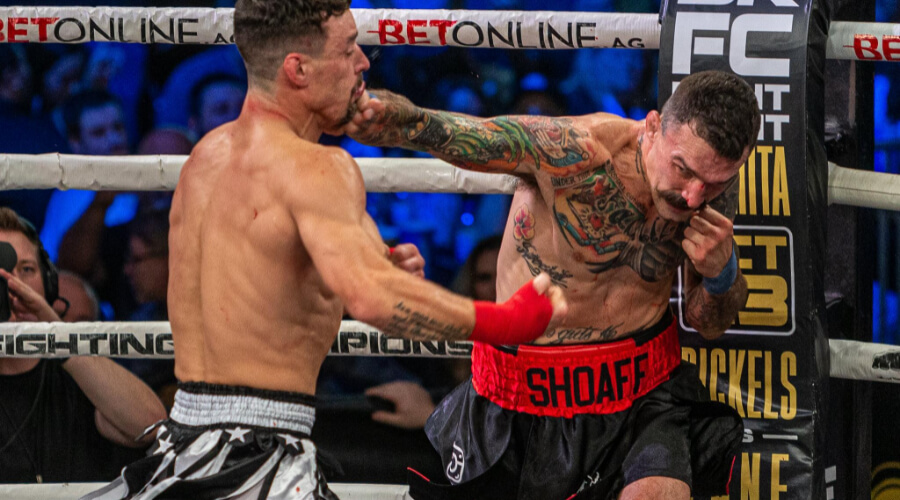Last Updated on October 16, 2023 by Alex PT
Bare-knuckle boxing techniques are similar to traditional boxing but with a few key differences. Fighters must be more careful with their punches, as there is no padding to protect their hands. They also tend to focus on more powerful punches, as they are less likely to cause breaks or fractures.
Bare Knuckle Boxing Techniques
1. The Jab Technique
Jab is considered the most essential technique in bare-knuckle boxing. This technique allows boxers to reach the opponent without getting too close and getting hit. The jab acts as a quick offensive move to maintain distance and defend against the opponent’s attacks while setting up powerful punches.
2. The Cross Punch
The cross punch, or straight punch, is a powerful straight punch thrown with the rear hand. In bare-knuckle boxing, it is fundamental to accurately target the softer parts of the opponent’s body to avoid injury to the boxer’s hand.
3. The Hook
The hook is a common and potent bare-knuckle boxing technique. It involves a punch thrown in an arcing motion. Precise target selection like temple or jaw is crucial to avoid hand injuries. This punch can be devastating due to its power and speed.
4. The Uppercut
Known for its brutal strength and speed, the uppercut is another important technique. While less frequently employed because of the exposure it creates, when timed and aimed right, it delivers a powerful punch to the opponent’s jaw or body.
5. The Overhand Punch
The overhand punch is a technique favored for its deceptive nature as it comes from an unusual angle that most boxers are not trained to defend against. It’s used less frequently than other techniques due to its energy consumption but can be very effective when landed.
6. The Stance and Footwork
Bare-knuckle boxers mostly use a square stance, ensuring a stable platform for both attack and defense. Mastery of footwork is important to maintain balance and optimum fighting range, either moving into the range to throw a punch or stepping back to dodge the opponent’s attack.
7. Body Punches
As bare-knuckle boxing requires preservation of the boxer’s hands, body punches are a key strategy. Here, the boxer targets softer areas like the abdomen or ribs, while avoiding hard areas like elbows or hips to prevent hand injuries.
| Technique | Description |
|---|---|
| 1. The Jab | A quick and offensive move to maintain distance |
| 2. The Cross Punch | A powerful straight punch is thrown with the rear hand |
| 3. The Hook | A punch was thrown in an arcing motion, aimed at the opponent’s temple or jaw |
| 4. The Uppercut | A punch aimed upward at the opponent’s chin or body |
| 5. The Overhand Punch | A punch was thrown from an unusual angle. |
| 6. Stance & Footwork | Utilizing a square stance and mastering footwork for balance and fighting range. |
| 7. Body Punches | Punches aimed at the body, targeting softer areas. |
These are some fundamental techniques within the world of bare-knuckle boxing. Each of them plays a crucial role in a boxer’s strategy and fighting style. Practicing these techniques regularly can lead to significant improvement in the boxer’s ability and overall performance. Remember, timing and accuracy, along with evasion tactics, are key elements in successful bare-knuckle boxing.
Advantages and Disadvantages of Bare Knuckle Boxing Techniques
Advantages of Bare Knuckle Boxing Techniques:
- Historical Significance: Bare-knuckle boxing has a rich historical legacy, reflecting the origins of modern boxing. Practitioners appreciate the sport’s connection to its roots.
- Strategy and Skill: Fighters often develop greater defensive and offensive skills since they must rely more on technique to avoid injuring their hands.
- Reduced Brain Trauma: Some proponents argue that without padded gloves, fighters are less likely to throw repeated head punches, potentially reducing the risk of brain injuries.
- Faster Fights: Bare-knuckle bouts can be shorter and more intense, as fighters aim for quick knockouts due to the risk of hand injuries.
Disadvantages of Bare Knuckle Boxing Techniques:
- Injury Risk: Bare-knuckle boxing carries a higher risk of hand and facial injuries. Fighters are prone to cuts, broken bones, and facial damage, which may result in long-term consequences.
- Limited Defense: Fighters may be less inclined to block punches with their hands, leading to more direct facial hits and potential for injuries.
- Regulatory Challenges: The sport faces regulatory hurdles and often operates in a legal gray area. This can lead to inconsistencies in fighter safety and match quality.
- Public Perception: Bare-knuckle boxing is seen by some as brutal and inhumane due to its perceived higher injury risk compared to gloved boxing, potentially limiting its mainstream acceptance.
- Lack of Standardization: Rules and safety measures can vary between different promotions and organizations, leading to inconsistency in fighter protection and conduct.
Bareknuckle Boxing Today

Professional bare-knuckle boxing commonly referred to as Modern Bare-knuckle Combat is held, managed, and created by the World Bare-knuckle Boxing Association, Bare Knuckle Boxing based in the U.K., and the Bare-knuckle Fighting Championship. In 1889, the first regulated bare-knuckle boxing event took place in the United States. The sport was well regulated and it consisted of 17 rounds in which both the fighters had to score points or become the winner by a knockout
How To Train For Bare Knuckle Boxing
Strengthen Your Hands
In most combat sports like MMA, Muay Thai, and boxing, it is common for fetters to have boxing fractures. Bare-knuckle fighters are only advised to wrap their hands when engaging in hard sparring. This is mostly because hand wrapping that’s a common thing in boxing seems to make the fists more fragile and shakier. In order to condition your wrists and knuckles, you can start your drills by hitting heavy bags and focus mitts with the MMA gloves. Without any hand wraps and gloves, try to engage in at least a round of bag practice.
Wear Gloves Strategically
Generally, bare-knuckle boxers are not allowed to wear gloves. And that’s more of a reason why you can’t block punches the way you do in regular boxing. Punches thrown at your face will slip through your guard quite easily because the first is a lot smaller without gloves. Normally, bare-knuckle fighting involves boxers getting cut a lot more which leads to more blood and injuries. But to be on the safe side, you can use regular boxing gloves for hard sparring periods. Furthermore, you can wear MMA gloves for hard sparring periods.
Take Care Of Your Hands
After every workout, you need to apply antibiotic ointment to any scrapes or abrasions on your hands. One way or the other, you must have scraped up your hands on the punching bag. So, doing this will ensure that you avoid infections and it will make the healing process faster. To relieve the discomfort and pains that you get from hitting your bare hands on the bag, put your knuckles and wrists on the ice for 20 to 30 minutes after every workout. After you’re done icing the knuckles and wrists, you can then use bandages on any part of your hands that needs them to ensure it does fall off.
FAQs
How Do Boxers Train For Bare Knuckles?
Try to do some shadow boxing and as many reps as possible (AMRAP) of Medicine Ball Ab Smash. Also, try some seven rounds of Bare Knuckle Scrapper Cardio Workouts Treadmill to Pads. Furthermore, you should engage yourself in five rounds, two minutes each of Resistance Band Shadowboxing, and do some Neck Ups for about 200 reps in total. Lastly, do some rope jumping for at least 10 minutes.
How Dangerous Is Bare-knuckle Boxing?
Bare-knuckle boxing is more dangerous than regular boxing where padded gloves are used. With over 12 rounds in the game, fighters get serious facial and bodily injuries and even brain damages. A fighter can be knocked outwit only one shot in bare-knuckle. If you’re not physically and mentally capable, you should never think of bare-knuckle boxing.
Is bare-knuckle Boxing illegal?
No! Not anymore. In the United States, Professional bare-knuckle boxing was illegal under any federal or state laws not until Wyoming became the first to legalize the combat sport on the 28th of March 2018.
Are Boxing Gloves More Dangerous Than Bare Knuckles?
No! Boxing gloves aren’t more dangerous than bare knuckles. Some may say that boxing gloves cause more long-term injury to the face over bare-knuckle. But that’s not entirely true. A recent study shows that the risk of death from bare-knuckle boxing is at 14,000 deaths per million fighters. However, the risk of death from modern professional boxing is at 76 deaths per million boxers. That means that bare-knuckle boxing is 184 times more deaths per million fighters than modern professional boxing.
Did bare-knuckle Boxers Rub Salt On Their Skin?
Yes! Some bare-knuckle boxers rub salt on their skin, especially the skin around the eyes to harden it. The salt dries out the skin, causing it to thicken scantily.
Is Bare-knuckle Boxing Good For Self-defense?
Yes! A bare-knuckle fighter can stand his ground against any would-be attacker. Though contemporary boxing isn’t quite as effective as some other martial arts, Bare-knuckle boxing is still good for self-defense.
Closing Thought
Just like we stated above, bare-knuckle boxing techniques primarily involve striking your opponent with bare hands. Ancient bare-knuckle boxing also involves the use of kicks, throws, and submissions to defeat your opponent. We’ve reached the closing chapter of this informative article. We hope you were able to find good resources in your quest to know bare-knuckle boxing techniques. If you have any questions or comments about the article topic, don’t hesitate to contact us. Thanks.
References:
https://en.wikipedia.org/wiki/Bare-knuckle_boxing
https://www.quora.com/How-do-boxers-train-for-bare-knuckles

Hi! I’m Alex PT. I hold a Bachelor’s degree in Sports Management from Indiana University and have over seven years of valuable experience working in a Sports Event Management Company. I founded SportBlurb with the passion for bringing you the latest, most insightful, and engaging content in the world of sports. So, whether you’re a die-hard fan or want to stay informed, I’ve got you covered!

